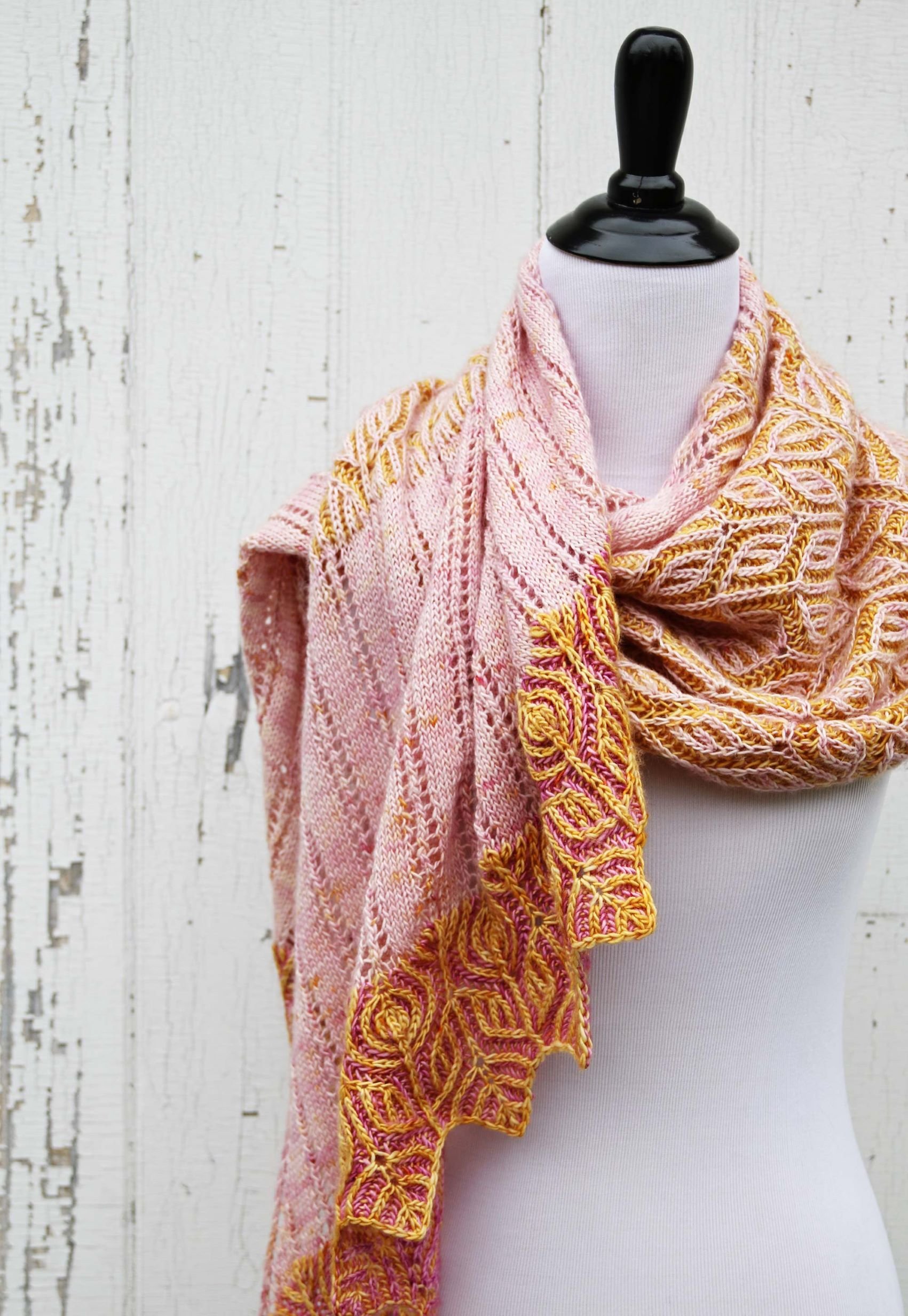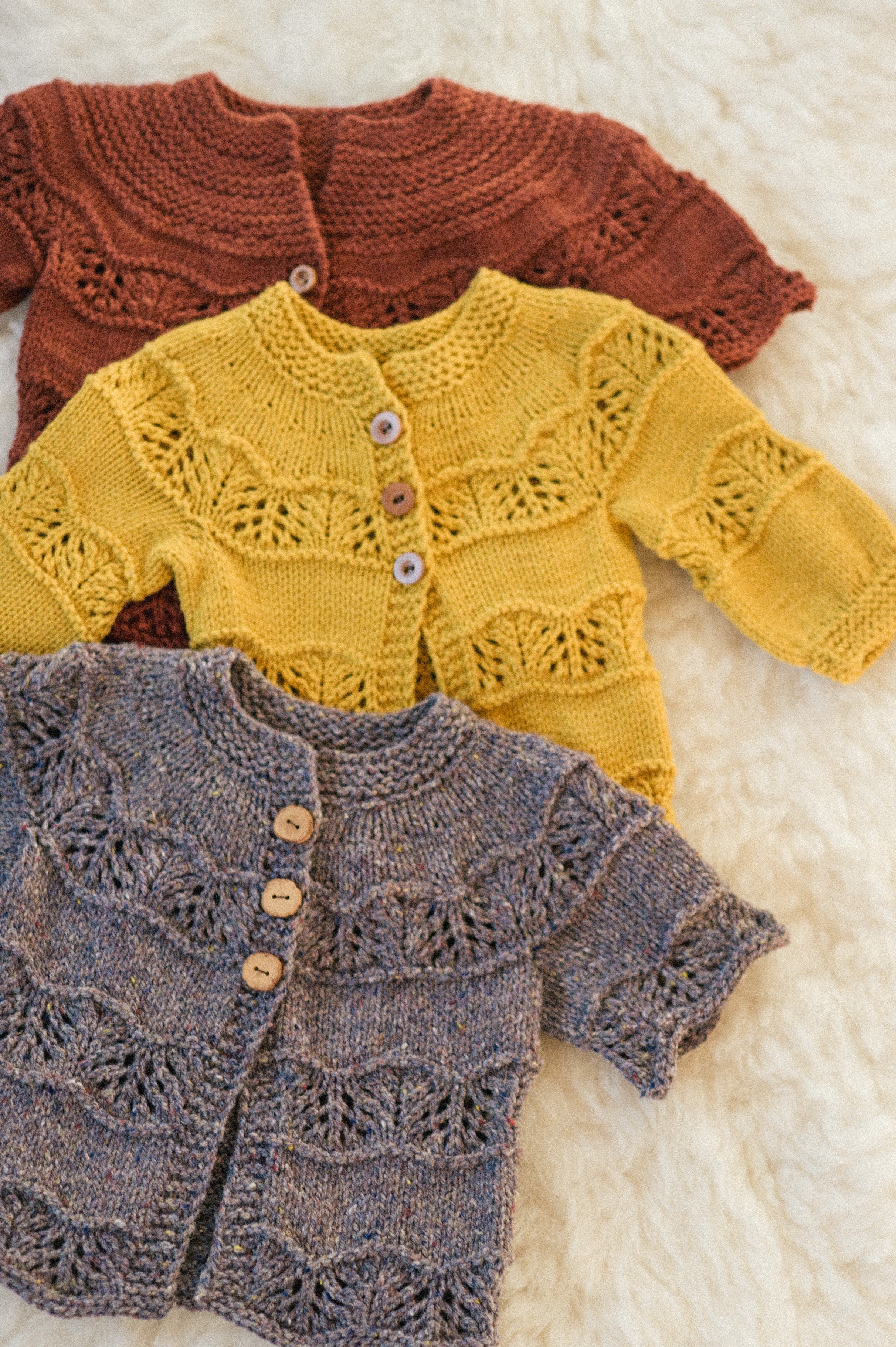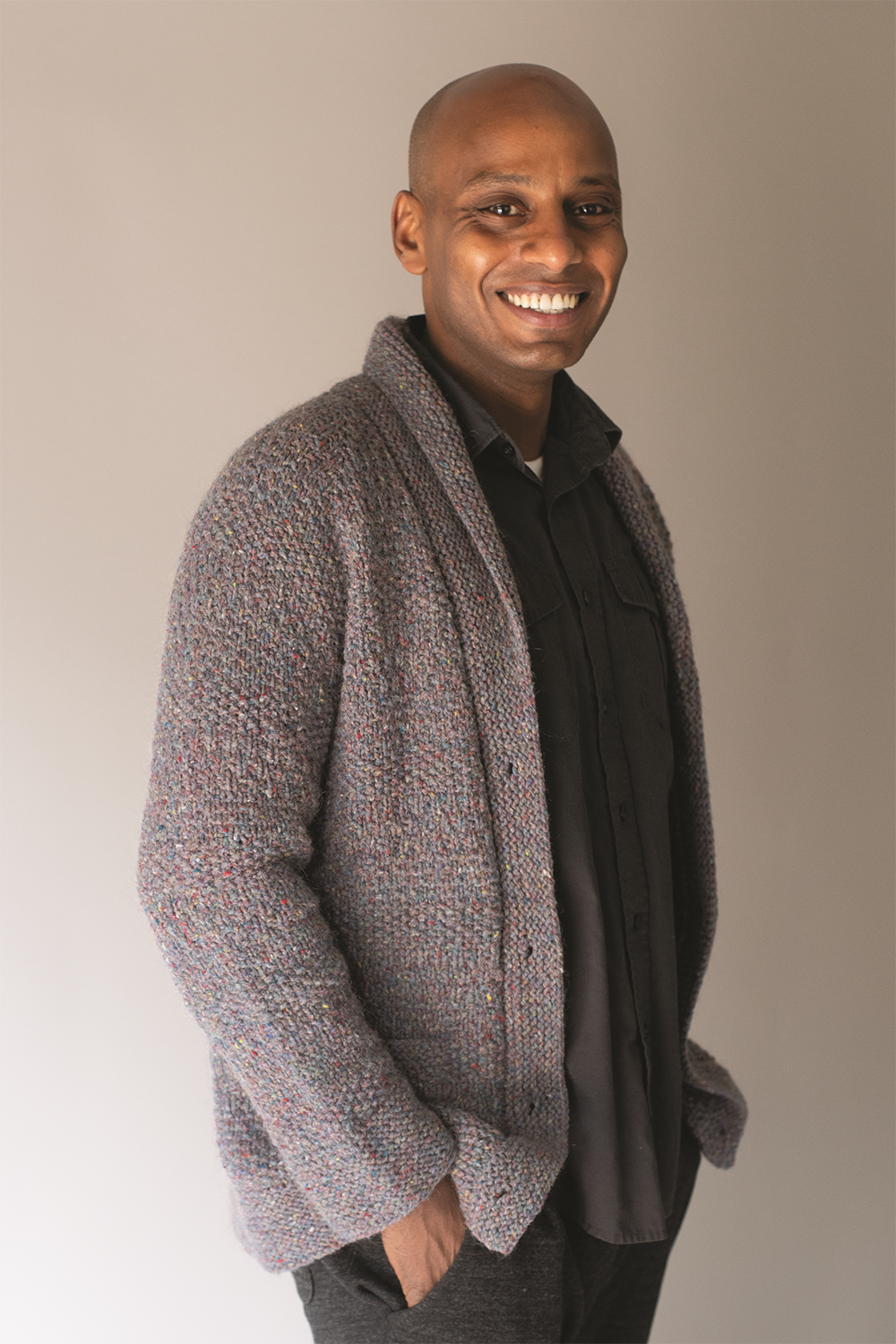Purls of Wisdom
Five Maine handknitting designers talk about their craft.
Alicia Plummer wearing her Covered wrap/shawl. PHOTO: JUSTIN BRISSETTE.
By June Donenfeld
ON A CLEAR, STILL EVENING IN AUGUST, I went to listen to an outdoor acoustic jam session in my small, Midcoast village, accompanied by the half-finished turquoise cardigan that I was knitting for an old friend in Sweden. I beavered away on it for the next two hours. As the last note died away on the chilly air, I spotted someone sporting a handknit sweater and smiling in my direction. She came over, introduced herself as a fellow knitter, said that there was a local knitting group and might I be interested in joining?
This was not the first time I’d been approached by perfect strangers eager to establish a connection through knitting as I’ve knitted away in airplanes, cafés or movie theatres. Thanks to yarn and needles, I’ve made friends up and down the generational ladder, been able to scratch my creative itch, express my love, and learned about science, medicine, history, anthropology, and politics along the way.
Rock Rose sweater by Amanda Scheuzger.
PHOTO COURTESY OF NORTH LIGHT
Knitting might have started as a purely practical craft that enabled human beings to protect themselves from the elements (or other human beings), but now many studies have shown that it has significant health and social benefits, from lowering heart rate (which is why it’s been called the “new yoga”) to releasing serotonin, reducing stress, preventing cognitive impairment, combatting addiction, and even teaching vital life skills to the incarcerated.
All these surprising aspects aside, knitting also offers a raft of other pluses: community, the joy of creation, aesthetic pleasure (think form, color, texture), or the chance to experience the magic of giving, whether to family, friends or charities that distribute handknits—from beanies to blankets—to people and animals in need. And lest you (or someone you know) think that knitting is limited to the female half of the world’s population, and done only by older generations, those 365 million online search results that pop up in less than a second just might make you change your mind.
Nowhere is there a better place to practice this time-honored yet contemporary craft than Maine, with its many yarn stores, dyers, mills and strikingly high number of accomplished independent knitting designers with both national and international followings. Pre-internet, designers would publish their patterns in print magazines or books, or even as single patterns commissioned by yarn companies and sold through yarn stores. But everything changed with the advent of the Web, which has enabled them to showcase their work via Instagram, for example, and self-publish digitally, either through their own websites or, most commonly, that worldwide knitting and crochet leviathan, Ravelry, a free online platform with more than 9 million members and the world’s largest pattern database.
We spoke with some of these remarkable designers recently, to learn about their backgrounds, design processes and inspirations.
The roads taken
Matt Akers, Alicia Plummer, Kim Hamlin, Leila Raven and Amanda Scheuzger all pointed to the role that serendipity played in how they came to be knitting designers. Now in his early twenties, Akers learned how to knit from his grandmother, who was eager to find an activity for the active eight-year-old that would keep him sitting still for more than two minutes on end. Later, he found knitting a terrific way to counter the stress of his academic demands in college, then went on to test-knit for established designers, design his own works, and accept a one-year position as Designer in Residence at SweetGeorgia, an artisan yarn and fiber arts company with a global presence. And though he is now preparing for a career as a dentist, he says he has no intention of giving up either knitting or design.
Matt Akers in his Curious Labyrinth cowl. COURTESY PHOTO.
Alicia Plummer started down her design path about two years after she began knitting in 2009, when she couldn’t find patterns that fit her lifestyle in rural Maine, where she “needed pieces that were simple yet well fitted, that would be equally at home at a local restaurant, a soccer game or stacking firewood in the yard.” She also wanted pieces “that reflected the rugged landscape” around her and “told stories of being out in the elements.” So she started to design garments that were “simple and intuitive but with special details that made the actual knitting interesting as well. Each piece also told a story, and that new canvas of self-expression was huge for me,” she says.
Maine-native Kim Hamlin moved to New York City after college to pursue a career in modern dance. But she also had rent to pay, and, purely by chance, landed a job at the then-tiny, newly opened yarn shop, Purl Soho, now greatly expanded and wildly successful. Though she had never knit from a pattern, the self-starter taught herself through books and magazines and “making a mountain of hats.” Despite her subsequent success as a designer there, including patterns for a book and a well-known natural fiber yarn company, Hamlin says she always “knew I wanted to come back to Maine.” So she moved to Norway in 2005, where, through a series of happy events, she eventually co-founded Fiber & Vine, a beloved yarn and wine store right in the middle of town.
Leila Raven, Creative Director at Maine-based Making magazine, also learned most of her knitting skills by working through patterns on her own, then started sharing some of her own designs online on Flickr in the mid-2000s. “A number of people expressed interest in knitting them, so I gave it a try and self-published my first patterns,” she says. “Soon after, I began designing patterns for yarn companies as well as various knitting publications.”
Amanda Scheuzger. PHOTO KATE SFEIR
Amanda Scheuzger wears two hats: one as a knitting designer and dyer, the other as a founding partner and designer at architectural, graphic and web design firm Medomak Designs in Waldoboro. Both a longtime knitter and a former student of architecture, she reports how much she liked redesigning, reimagining or tweaking designs she saw. She published her first pattern—a simple bowl—with Interweave Knits, then became a regular contributor to this highly regarded media company, as well as to the magazines Knit.wear, Wool Studio, Twist Collective, Knit Purl and Knitscene. She eventually started self-publishing and then fell in love with hand-dyeing yarn in 2018, which offered “a different and equally exciting design challenge, one whose creative process is a perfect complement” to the patterns she continues to create.
It's a process
To develop their patterns, these designers may head to their stitch dictionaries, an especially beautiful yarn, stunning Maine land- or seascapes, or even inside their mind’s eyes to capture a memory of time or place. Whatever their inspiration, all five derive deep satisfaction from their work. In addition to the rhythmic act of knitting that she loves, Plummer also feels great joy when someone knits one of her patterns and “makes that story their own.” Her designs have been “companions for people in times of immense joy and also grief,” she says. “That is a heavy honor, and one I take seriously.” Plummer is surprised at the effect she’s had on others through her patterns, because, she says, “What started as a simple space for self-expression has also become a platform for shared experience, connection— sometimes across vast distances.”
Leila Raven wearing her ‘Onipa’a shawl. COURTESY PHOTO.
Raven cherishes “the deeper sense of purpose in the craft, the underlying meanings and connection that comes with sharing it with others, and the sheer practicality of knowing how to create fabric from needles and a single strand of fiber… something that requires time, skill, and patience.” She also sees knitting as a potential vehicle for something more philosophical, feeling that it’s “even possible to gain insight and fuller understanding through the act of knitting that we can apply to other areas of our lives.”
Hamlin, too, points to the human connection as one of her sources of gratification: “I love sharing my knowledge with people, the interactions I have with them, and the opportunities I have to offer encouragement.”
And both Scheuzger and Akers are always delighted to see what knitters create from their patterns with the choices they make for color, shape, yarn or pattern tweaks. Akers says, “I love seeing what other people create— I’m always amazed at what they do, and it makes my heart happy each time to see their work. I also want people to feel confident in their abilities and if by knitting one of my patterns, they get there, that’s wonderful, too. Knowing how much joy I get from knitting myself, it’s exciting to be part of someone else’s.”
The power of balance
As with any profession, knitting design comes with its fair share of challenges. For Raven, it’s designing to a deadline, as, she says, “Inspiration doesn’t come with an on/off switch, and sometimes it’s hard to coax an idea into being within a specified window of time.” Plummer, on the other hand, finds that the most difficult aspect of her work is managing her social media content, including “taking and editing lots of pictures, writing the captions, answering emails, and managing the feed.” Hamlin says that her biggest challenge is balancing her many design ideas with the work that will sustain her, while Akers can find it frustrating that about one out of four designs he starts by picking up needles and yarn doesn’t work out, at least not at first—and sometimes never. And as Scheuzger nutshelled it: “So many ideas and so little time!”
Casting off
Knitting, however prosaic or strictly a domestic activity it may seem, has also played a role in U.S. history and culture, including the American Revolution, when it was seen as a way to resist Britain, whose manufacturers churned out the lion’s share of the colony’s knitted goods. Today, there are other aspects of hand knitting that reflect the cultural zeitgeist, one of which is a recognition of the need for inclusiveness. The good news there is that though there is still work to be done, the new ways to self-publish have made it much easier for designers to gain recognition for their work.
And there have been other positive changes in the knitting world, too. Raven says she’s witnessed “a heartening, growing willingness in the online knitting world to discuss the deeper issues of our society and world at large, like racial inequality, gender identity, and climate change, critical issues of our time that require frank, open discussion, and meaningful action, so that we can grow as a community.” She even sees “a greater awareness of the impact our individual choices have on the planet at large, and how we can make small shifts in the way we approach even a simple thing like a knitting project with more mindfulness, whether that’s through selection of the materials we use, or the businesses we support with our purchases.”
Clearly, there’s a lot more to knitting than meets the eye, and even if you haven’t been bitten by the knitting bug yourself, you may never look at a ball of yarn the same way again. And that’s a good thing.
Kim Hamlin in her Western Foothills wrap. PHOTO: EMILY DELAMATER
Maine knitting/crochet designers, yarn dyers, fiber farms and fiber mills
Key: Designer = D, FF = fiber farm, FM = fiber mill, YD = yarn dyer
A Wrinkle in Thyme Farm (FF, YD)
Alicia Plummer (D)
Amanda Scheuzger (D)
Andrea Mowry (D)
Bag End Suri Alpacas of Maine LLC (FF, YD)
Bartlett Yarns (FM)
Bittersweet Heritage Farm (FF, YD)
Bristol Ivy (D)
Catawampus Farm (FF, YD)
Done Roving (YD)
Echo Valley Farm (FF)
Elizabeth Smith (D)
Gail Pfeifle (D)
Gallifreyan Farm (FF, YD)
Good Karma Farm (FF, FM, YD)
Hannah Fettig (D)
Harbor Fibres (YD)
Hélène Rush (D)
Hunter Hammersen (D)
Jaggerspun (FM)
Kim Hamlin (D)
Kristen TenDyke (D)
Lana Plantae Farmed Yarns (FF, YD)
Leah B. Thibault (D)
Leila Raven (D)
Linda Courtney (D)
Linda Perry, Harbor Yarns (D, YD)
Lori Versaci (D)
Mindful Folk Farm (FF, YD)
Nezincot Farm (FF, YD)
On the Round Yarn (YD)
Pam Allen (D)
Pinestar Studio (YD)
Raymond Brook Farm (FF)
Rockin’ Sheep Farm (FF)
Seven Sisters Arts (YD)
Shepherds Craft Farm (FF)
Spunky Eclectic / Moka Farm (FF, YD)
Starboard Farm (FF)
Swans Island (YD)
TLC Fiber Farm (FF)
Underhill Fibers (FF, FM)
Fiber farm spotlight: Lana Plantae
For more than two decades, Marcia MacDonald, her husband Desmond, and their children Kaya and Desi, have been raising alpaca and sheep on their sustainable farm in Buxton, and making beautiful, naturally dyed, small-batch yarn. An Ogunquit native, Marcia spent many years on the Caribbean island of St. Kitts, where Desmond is from. Between his childhood experience with his own flock of sheep and Marcia’s degree in horticulture and love of plants, they were almost destined to run a fiber farm and use natural materials to dye their flocks’ wool. Marcia reports that the buy-local movement continues to expand in Maine, and that “fiber and textiles are increasingly part of the picture.” She’s also noticed a lot of interest in natural dyes of late, especially among younger people. All this is great news for Maine fiber farmers, purveyors of their products, and knitters everywhere.












